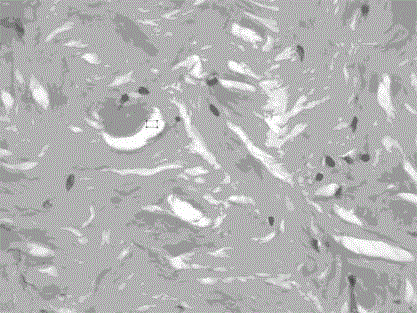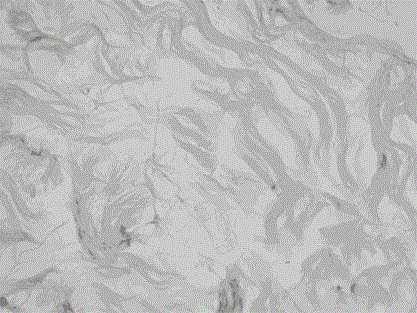Preparing method of heterogeneous acellular dermal matrix substrate with good biocompatibility
A decellularized dermis and biocompatibility technology, applied in the field of preparation of heterogeneous acellular dermal matrix, can solve the problems of crosslinking agent toxicity, uncontrollable, unstable cytotoxicity, etc., to reduce the dielectric constant and improve tissue phase Capacitance, the effect of protecting physical properties
- Summary
- Abstract
- Description
- Claims
- Application Information
AI Technical Summary
Problems solved by technology
Method used
Image
Examples
Embodiment 1
[0068] (1) Preparation of tomographic skin slices
[0069] Take 0.6mm thick porcine split skin slices, cut into 5*7cm size, wash with PBS three times, remove fat with 0.1% Promojieer for 30 minutes, then wash with PBS three times;
[0070] (2) Separation of epidermis and dermis
[0071] Soak the split skin piece obtained in step (1) with 0.2% (mass volume ratio g / 100ml) trypsin in PBS solution at 20°C for 16 hours, wash with 70% ethanol for 8 hours, and wash with 3% hydrogen peroxide for 15 minutes, then Wash with PBS for 3 times, then wash with purified water for 24 times, and change the medium every 1 hour;
[0072] (3) Decellularization treatment
[0073] Wash the material after step (2) with 0.3% (mass volume ratio g / 100ml) SDS aqueous solution for 4 hours, wash with 4% ethanol for 4 hours, continue to wash with purified water for 12 times, change the medium every 1 hour, and finally PBS Wash with liquid 24 times, change the liquid every two hours;
[0074] (4) Cross-l...
Embodiment 2
[0085] (1) Preparation of tomographic skin slices
[0086] Take a 0.6mm thick sectioned animal skin slice, cut it into 5*7cm size, wash it three times with PBS solution, remove fat with 0.1% Promojieer for 30 minutes, and then wash it three times with PBS solution;
[0087] (2) Separation of epidermis and dermis
[0088] Use 0.15% (mass volume ratio g / 100ml) trypsin in PBS solution to soak the split skin piece obtained in step (1) at 4°C for 30 hours, wash with 40% ethanol for 10 hours, and wash with 3% hydrogen peroxide for 15 minutes. Then wash 3 times with PBS, then wash 24 times with purified water, and change the medium every 1 hour;
[0089] (3) Decellularization treatment
[0090] Wash the material after step (2) with 0.1% (mass volume ratio g / 100ml) SDS aqueous solution for 6 hours, 2% ethanol for 6 hours, continue to wash with purified water for 12 times, change the medium every 1 hour, and finally PBS Wash with liquid 24 times, change the liquid every two hours; ...
Embodiment 3
[0101] (1) Preparation of tomographic skin slices
[0102] Take a 0.6mm thick sectioned animal skin slice, cut it into 5*7cm, wash it three times with PBS solution, remove fat with 0.1% Promogeril for 30 minutes, and wash it three times with PBS solution;
[0103] (2) Separation of epidermis and dermis
[0104] Use 0.25% (mass volume ratio g / 100ml) of trypsin in PBS solution obtained in step (1), soak for 24 hours at 10°C, wash with 75% ethanol for 6 hours, and wash with 3% hydrogen peroxide for 15 minutes. Then wash 3 times with PBS, then wash 24 times with purified water, and change the medium every 1 hour;
[0105] (3) Decellularization treatment
[0106] Wash the material after step (2) with 0.5% (mass volume ratio g / 100ml) SDS aqueous solution for 3 hours, wash with 10% ethanol for 2 hours, continue to wash with purified water for 12 times, change the medium every 1 hour, and finally PBS Wash with liquid 24 times, change the liquid every two hours;
[0107] (4) Cross-...
PUM
 Login to View More
Login to View More Abstract
Description
Claims
Application Information
 Login to View More
Login to View More - R&D
- Intellectual Property
- Life Sciences
- Materials
- Tech Scout
- Unparalleled Data Quality
- Higher Quality Content
- 60% Fewer Hallucinations
Browse by: Latest US Patents, China's latest patents, Technical Efficacy Thesaurus, Application Domain, Technology Topic, Popular Technical Reports.
© 2025 PatSnap. All rights reserved.Legal|Privacy policy|Modern Slavery Act Transparency Statement|Sitemap|About US| Contact US: help@patsnap.com



